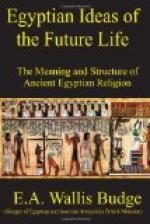The centre and home of the worship of Osiris in Egypt under the early dynasties was Abydos, where the head of the god was said to be buried. It spread north and south in the course of time, and several large cities claimed to possess one or other of the limbs of his body. The various episodes in the life of the god were made the subject of solemn representations in the temple, and little by little the performance of the obligatory and non-obligatory services in connection with them occupied, in certain temples, the greater part of the time of the priests. The original ideas concerning the god were forgotten and new ones grew up; from being the example of a man who had risen from the dead and had attained unto life everlasting, he became the cause of the resurrection of the dead; and the power to bestow eternal life upon mortals was transferred from the gods to him. The alleged dismemberment of Osiris was forgotten in the fact that he dwelt in a perfect body in the underworld, and that, whether dismembered or not, he had become after his death the father of Horus by Isis. As early as the XIIth dynasty, about B.C. 2500, the worship of this god had become almost universal, and a thousand years later Osiris had become a sort of national god. The attributes of the great cosmic gods were ascribed to him, and he appeared to man not only as the god and judge of the dead, but also as the creator of the world and of all things in it. He who was the son of R[=a] became the equal of his father, and he took his place side by side with him in heaven.
We have an interesting proof of the identification of Osiris with R[=a] in Chapter XVII. of the Book of the Dead. It will be remembered that this Chapter consists of a series of what might almost be called articles of faith, each of which is followed by one or more explanations which represent one or more quite different opinions; the Chapter also is accompanied by a series of Vignettes. In line 110 it is said, “I am the soul which dwelleth in the two tchafi, [Footnote: i.e., the souls of Osiris and R[=a].] What is this then? It is Osiris when he goeth into Tattu (i.e., Busiris) and findeth there the soul of R[=a]; there the one god embraceth the other, and souls spring into being within the two tchafi.” In the Vignette which illustrates this passage the souls of R[=a] and Osiris are seen in the forms of hawks standing on a pylon, and facing each other in Tattu; the former has upon his head a disk, and the latter, who is human-headed, the white crown. It is a noticeable fact that even at his meeting with R[=a] the soul of Osiris preserves the human face, the sign of his kinship with man.




